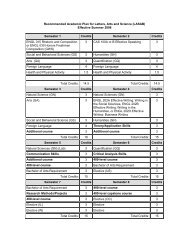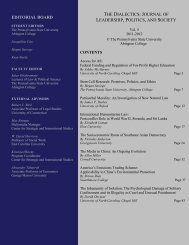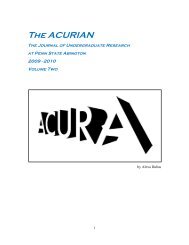Vol. III - Penn State Abington
Vol. III - Penn State Abington
Vol. III - Penn State Abington
Create successful ePaper yourself
Turn your PDF publications into a flip-book with our unique Google optimized e-Paper software.
the current financial crisis. Just four days before Enron’s bankruptcy, these agencies hurried to<br />
down rate it, which greatly pricked up the volatility of the market (U.S. Securities and Exchange<br />
Commission, 2002).<br />
Credit rating agencies’ behavior aroused controversy over their credibility, and brought in<br />
the Rating Agency Act in September 2006. However, the Commission did not vote to apply<br />
these rules to the NRSRO until June 18th, 2007, and they became effective on July 26th, 2007,<br />
when the subprime mortgage problem had already emerged (U.S. Securities and Exchange<br />
Commission, 2008:4).<br />
2) Facilitating Monopoly<br />
By the 1970s, the credit rating industry had gradually become dominated by the big three.<br />
They had an overwhelming voice to affect investors’ investments in financial market, although<br />
their rating was still comparatively reliable.<br />
Meanwhile, the economic recession of the 1970s triggered a debt crisis, and regulators<br />
tried to control investments’ risk through credit rating reports. In 1975, U.S. security exchange<br />
commission declared minimum criteria on agents/dealers’ clearance (Securities Exchange Act,<br />
1934:Rule 15c3-1). For the first time, the rating results of the National Recognized Statistical<br />
Rating Organization (NRSRO) were considered as part of the legal system of federal security<br />
supervision. This rule stated that when calculating net capital, agents/dealers have to discount a<br />
certain percentage of it from the market value of the securities they hold, in order to mitigate the<br />
effect of price fluctuation in market. But if these securities are rated as the first two grades of the<br />
highest credit rating by at least two NRSRO, the discount on their market value can be largely<br />
reduced (Securities Exchange Act, 1934:Rule 15c3-1).<br />
Afterwards, more rules related to NRSRO credit rating were brought in. In 1982, the SEC<br />
revised the information disclosure rule. It confirmed that if unconvertible bonds or unconvertible<br />
limited securities are rated as investible securities by at least one NRSRO, they will be able to<br />
use the S-3 form, the simplest and least informative way to release their business information. In<br />
1996, the SEC stipulated that currency market funds can only invest in high-quality short-term<br />
financial tools, using an investment portfolio based on NRSRO rating results. Even the U.S.<br />
Department of Education required new financial responsibility from organizations that sought to<br />
join the student loan program, by submitting to NRSRO ratings. In a report submitted to US<br />
senators by the SEC, at least eight federal laws, 47 Federal regulations or rules and more than<br />
100 local laws at that time used NRSRO rating results as regulation criterion (U.S. Securities and<br />
Exchange Commission, 2002).<br />
In this way, government’s reliance on NRSRO greatly magnified the already strong voice<br />
of these CRAs. Investors become increasingly credulous towards the rating results. Security<br />
issuers now had to apply for a rating from NRSRO to benefit from good ratings. The voluntary<br />
credit rating system had gradually become an established process, which further weakened the<br />
reputation capital mechanism.<br />
What was worse was the lack of objective or clear statements on NRSRO licensing<br />
conditions and procedures for a long time. From 1975 to 2003, there were few credit rating<br />
agencies licensed as NRSRO, apart from the big three. Even though there were some, they were<br />
taken over by the big three after all (Yu, 2008). So the NRSRO greatly strengthened the current<br />
monopoly situation in the credit rating market. And these big three gradually changed from<br />
private business organizations into some kind of regulators. Although these agencies were<br />
THE DIALECTICS ▲ 2009<br />
www.abington.psu.edu/dialectics<br />
34







